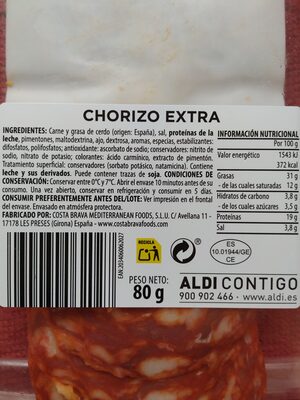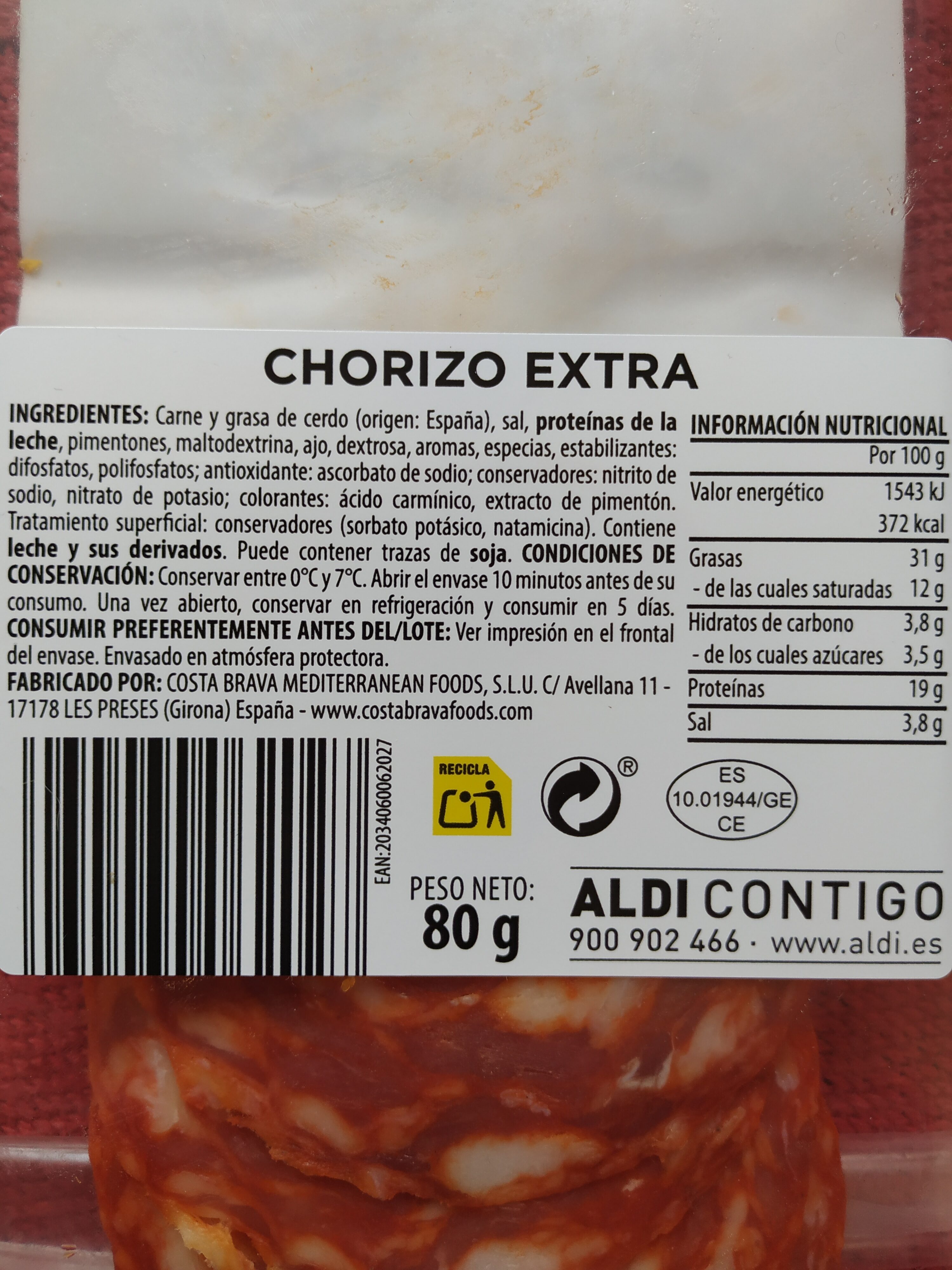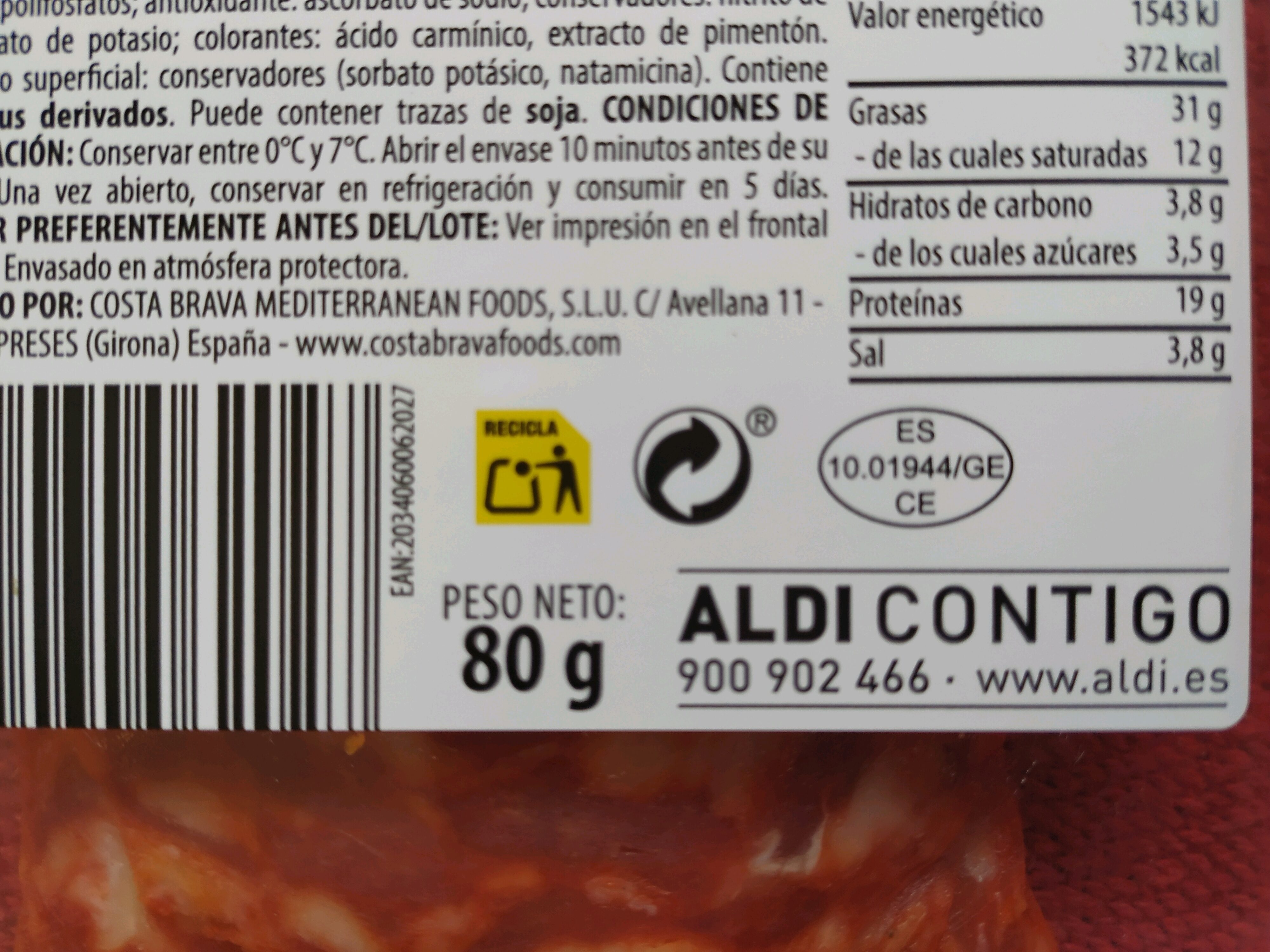Help us make food transparency the norm!
As a non-profit organization, we depend on your donations to continue informing consumers around the world about what they eat.
The food revolution starts with you!
Chorizo extra sin gluten - La tabla - 80g
Chorizo extra sin gluten - La tabla - 80g
This product page is not complete. You can help to complete it by editing it and adding more data from the photos we have, or by taking more photos using the app for Android or iPhone/iPad. Thank you!
×
Barra-kodea: 2034060062027 (EAN / EAN-13)
Kopurua: 80g
Markak: La tabla
Kategoriak: en:Meats and their products, en:Meats, en:Prepared meats, en:Cured sausages, Elikagai-gehigarri, Txorizo
Etiketak, ziurtagiriak, sariak: en:No gluten, en:Animal welfare, es:bienestar-animal
Saltzen diren herrialdeak: Espainia
Matching with your preferences
Health
Osagaiak
-
26 ingredients
Gaztelania: Carne y grasa de cerdo (origen: España), sal, proteínas de la leche, pimentones, maltodextrina, ajo, dextrosa, aromas, especias, estabilizantes: difosfatos, polifosfatos; antioxidante: ascorbato de sodio; conservadores: nitrito de sodio, nitrato de potasio; colorantes: ácido carmínico, extracto de pimentón. Tratamiento superficial: conservadores (sorbato potásico, natamicina) contiene leche y sus derivados. puede contener trazas de soja.Alergenoak: en:MilkAztarnak: en:Soybeans
Food processing
-
Ultra processed foods
Elements that indicate the product is in the 4 - Ultra prozesatutako elikagaiak eta edariak group:
- Gehigarria: E120 - Gorrimin
- Gehigarria: E160c
- Gehigarria: E450
- Gehigarria: E452
- Osagaia: Colour
- Osagaia: Dextrose
- Osagaia: Flavouring
- Osagaia: Glukosa
- Osagaia: Maltodextrin
- Osagaia: Milk proteins
Food products are classified into 4 groups according to their degree of processing:
- Prozesatu gabeko edo ahalik eta gutxien prozesatutako elikagaiak
- Sukaldaritzako osagaiak prozesatu
- Prozesatutako jakiak
- Ultra processed foods
The determination of the group is based on the category of the product and on the ingredients it contains.
Gehigarriak
-
E120 - Gorrimin
Carminic acid: Carminic acid -C22H20O13- is a red glucosidal hydroxyanthrapurin that occurs naturally in some scale insects, such as the cochineal, Armenian cochineal, and Polish cochineal. The insects produce the acid as a deterrent to predators. An aluminum salt of carminic acid is the coloring agent in carmine. Synonyms are C.I. 75470 and C.I. Natural Red 4. The chemical structure of carminic acid consists of a core anthraquinone structure linked to a glucose sugar unit. Carminic acid was first synthesized in the laboratory by organic chemists in 1991.Source: Wikipedia (Ingeles)
-
E202
Potassium sorbate: Potassium sorbate is the potassium salt of sorbic acid, chemical formula CH3CH=CH−CH=CH−CO2K. It is a white salt that is very soluble in water -58.2% at 20 °C-. It is primarily used as a food preservative -E number 202-. Potassium sorbate is effective in a variety of applications including food, wine, and personal-care products. While sorbic acid is naturally occurring in some berries, virtually all of the world's production of sorbic acid, from which potassium sorbate is derived, is manufactured synthetically.Source: Wikipedia (Ingeles)
-
E235
Natamycin: Natamycin, also known as pimaricin, is an antifungal medication used to treat fungal infections around the eye. This includes infections of the eyelids, conjunctiva, and cornea. It is used as eyedrops. Natamycin is also used in the food industry as a preservative.Allergic reactions may occur. It is unclear if medical use during pregnancy or breastfeeding is safe. It is in the macrolide and polyene families of medications. It results in fungal death by altering the cell membrane.Natamycin was discovered in 1955 and approved for medical use in the United States in 1978. It is on the World Health Organization's List of Essential Medicines, the most effective and safe medicines needed in a health system. The wholesale cost in the developing world is between US$92.90 and 126.72 per 5-ml bottle as of 2015. It is produced by fermentation of the bacterium Streptomyces natalensis.Source: Wikipedia (Ingeles)
-
E250
Sodium nitrite: Sodium nitrite is the inorganic compound with the chemical formula NaNO2. It is a white to slightly yellowish crystalline powder that is very soluble in water and is hygroscopic. It is a useful precursor to a variety of organic compounds, such as pharmaceuticals, dyes, and pesticides, but it is probably best known as a food additive to prevent botulism. It is on the World Health Organization's List of Essential Medicines, the most important medications needed in a basic health system.Nitrate or nitrite -ingested- under conditions that result in endogenous nitrosation has been classified as "probably carcinogenic to humans" by International Agency for Research on Cancer -IARC-.Source: Wikipedia (Ingeles)
-
E252
Potassium nitrate: Potassium nitrate is a chemical compound with the chemical formula KNO3. It is an ionic salt of potassium ions K+ and nitrate ions NO3−, and is therefore an alkali metal nitrate. It occurs in nature as a mineral, niter. It is a source of nitrogen, from which it derives its name. Potassium nitrate is one of several nitrogen-containing compounds collectively referred to as saltpeter or saltpetre. Major uses of potassium nitrate are in fertilizers, tree stump removal, rocket propellants and fireworks. It is one of the major constituents of gunpowder -black powder- and has been used since the Middle Ages as a food preservative.Source: Wikipedia (Ingeles)
-
E301
Sodium ascorbate: Sodium ascorbate is one of a number of mineral salts of ascorbic acid -vitamin C-. The molecular formula of this chemical compound is C6H7NaO6. As the sodium salt of ascorbic acid, it is known as a mineral ascorbate. It has not been demonstrated to be more bioavailable than any other form of vitamin C supplement.Sodium ascorbate normally provides 131 mg of sodium per 1‚000 mg of ascorbic acid -1‚000 mg of sodium ascorbate contains 889 mg of ascorbic acid and 111 mg of sodium-. As a food additive, it has the E number E301 and is used as an antioxidant and an acidity regulator. It is approved for use as a food additive in the EU, USA, and Australia and New Zealand.In in vitro studies, sodium ascorbate has been found to produce cytotoxic effects in various malignant cell lines, which include melanoma cells that are particularly susceptible.Source: Wikipedia (Ingeles)
Ingredients analysis
-
en:Palm oil free
No ingredients containing palm oil detected
Unrecognized ingredients: es:origen, es:pimentones, es:tratamiento-superficialSome ingredients could not be recognized.
We need your help!
You can help us recognize more ingredients and better analyze the list of ingredients for this product and others:
- Edit this product page to correct spelling mistakes in the ingredients list, and/or to remove ingredients in other languages and sentences that are not related to the ingredients.
- Add new entries, synonyms or translations to our multilingual lists of ingredients, ingredient processing methods, and labels.
If you would like to help, join the #ingredients channel on our Slack discussion space and/or learn about ingredients analysis on our wiki. Thank you!
-
en:Non-vegan
Non-vegan ingredients: en:Meat, Txerri-gantz, en:Milk proteins, E120Some ingredients could not be recognized.
We need your help!
You can help us recognize more ingredients and better analyze the list of ingredients for this product and others:
- Edit this product page to correct spelling mistakes in the ingredients list, and/or to remove ingredients in other languages and sentences that are not related to the ingredients.
- Add new entries, synonyms or translations to our multilingual lists of ingredients, ingredient processing methods, and labels.
If you would like to help, join the #ingredients channel on our Slack discussion space and/or learn about ingredients analysis on our wiki. Thank you!
-
en:Non-vegetarian
Non-vegetarian ingredients: en:Meat, Txerri-gantz, E120Some ingredients could not be recognized.
We need your help!
You can help us recognize more ingredients and better analyze the list of ingredients for this product and others:
- Edit this product page to correct spelling mistakes in the ingredients list, and/or to remove ingredients in other languages and sentences that are not related to the ingredients.
- Add new entries, synonyms or translations to our multilingual lists of ingredients, ingredient processing methods, and labels.
If you would like to help, join the #ingredients channel on our Slack discussion space and/or learn about ingredients analysis on our wiki. Thank you!
-
Details of the analysis of the ingredients
We need your help!
Some ingredients could not be recognized.
We need your help!
You can help us recognize more ingredients and better analyze the list of ingredients for this product and others:
- Edit this product page to correct spelling mistakes in the ingredients list, and/or to remove ingredients in other languages and sentences that are not related to the ingredients.
- Add new entries, synonyms or translations to our multilingual lists of ingredients, ingredient processing methods, and labels.
If you would like to help, join the #ingredients channel on our Slack discussion space and/or learn about ingredients analysis on our wiki. Thank you!
es: Carne, grasa de cerdo (origen), sal, proteínas de la leche, pimentones, maltodextrina, ajo, dextrosa, aromas, especias, estabilizantes (difosfatos), polifosfatos, antioxidante (ascorbato de sodio), conservadores (nitrito de sodio), nitrato de potasio, colorantes (ácido carmínico), extracto de pimentón, Tratamiento superficial (conservadores, sorbato potásico), natamicina- Carne -> en:meat - vegan: no - vegetarian: no - percent_min: 5.26315789473684 - percent_max: 100
- grasa de cerdo -> en:pork-fat - vegan: no - vegetarian: no - from_palm_oil: maybe - ciqual_food_code: 16530 - percent_min: 0 - percent_max: 50
- origen -> es:origen - percent_min: 0 - percent_max: 50
- sal -> en:salt - vegan: yes - vegetarian: yes - ciqual_food_code: 11058 - percent_min: 0 - percent_max: 33.3333333333333
- proteínas de la leche -> en:milk-proteins - vegan: no - vegetarian: yes - percent_min: 0 - percent_max: 25
- pimentones -> es:pimentones - percent_min: 0 - percent_max: 20
- maltodextrina -> en:maltodextrin - vegan: yes - vegetarian: yes - percent_min: 0 - percent_max: 16.6666666666667
- ajo -> en:garlic - vegan: yes - vegetarian: yes - ciqual_food_code: 11000 - percent_min: 0 - percent_max: 14.2857142857143
- dextrosa -> en:dextrose - vegan: yes - vegetarian: yes - ciqual_proxy_food_code: 31016 - percent_min: 0 - percent_max: 12.5
- aromas -> en:flavouring - vegan: maybe - vegetarian: maybe - percent_min: 0 - percent_max: 5
- especias -> en:spice - vegan: yes - vegetarian: yes - percent_min: 0 - percent_max: 5
- estabilizantes -> en:stabiliser - percent_min: 0 - percent_max: 5
- difosfatos -> en:e450 - vegan: yes - vegetarian: yes - percent_min: 0 - percent_max: 5
- polifosfatos -> en:e452 - vegan: yes - vegetarian: yes - percent_min: 0 - percent_max: 5
- antioxidante -> en:antioxidant - percent_min: 0 - percent_max: 5
- ascorbato de sodio -> en:e301 - vegan: yes - vegetarian: yes - percent_min: 0 - percent_max: 5
- conservadores -> en:preservative - percent_min: 0 - percent_max: 5
- nitrito de sodio -> en:e250 - vegan: yes - vegetarian: yes - percent_min: 0 - percent_max: 5
- nitrato de potasio -> en:e252 - vegan: yes - vegetarian: yes - percent_min: 0 - percent_max: 5
- colorantes -> en:colour - percent_min: 0 - percent_max: 5
- ácido carmínico -> en:e120 - vegan: no - vegetarian: no - percent_min: 0 - percent_max: 5
- extracto de pimentón -> en:e160c - vegan: yes - vegetarian: yes - percent_min: 0 - percent_max: 5
- Tratamiento superficial -> es:tratamiento-superficial - percent_min: 0 - percent_max: 5
- conservadores -> en:preservative - percent_min: 0 - percent_max: 5
- sorbato potásico -> en:e202 - vegan: yes - vegetarian: yes - percent_min: 0 - percent_max: 2.5
- natamicina -> en:e235 - vegan: yes - vegetarian: yes - percent_min: 0 - percent_max: 5
Elikadura
-
Nutri-Score not-applicable
Not-applicable for the category: Elikagai-gehigarri
⚠ ️Nutri-Score not applicable for this product category.Could you add the information needed to compute the Nutri-Score?
-
Nutrition facts
Nutrition facts As sold
for 100 g / 100 mlCompared to: Txorizo Koipe ? Gantz-azido ase ? Carbohydrates ? Azukre ? Fiber ? Proteina ? Gatz arrunt ? Fruits‚ vegetables‚ nuts and rapeseed‚ walnut and olive oils (estimate from ingredients list analysis) 0,74 %
Ingurumena
-
Eco-Score D - High environmental impact
The Eco-Score is an experimental score that summarizes the environmental impacts of food products.→ The Eco-Score was initially developped for France and it is being extended to other European countries. The Eco-Score formula is subject to change as it is regularly improved to make it more precise and better suited to each country.Life cycle analysis
-
Average impact of products of the same category: D (Score: 35/100)
Kategoria: Spicy pork sausage with red pepper, no precision
Kategoria: Spicy pork sausage with red pepper, no precision
- PEF environmental score: 0.89 (the lower the score, the lower the impact)
- including impact on climate change: 6.17 kg CO2 eq/kg of product
Stage Impact Agriculture
78.5 %Processing
14.4 %Ontziratzea
0.5 %Transportation
1.8 %Distribution
1.0 %Consumption
3.8 %
Bonuses and maluses
-
Origins of ingredients with a medium impact
Bonus: +1
Environmental policy: -3
Transportation: +4
Origin of the product and/or its ingredients % of ingredients Impact Unknown 76 %Altua Espainia 24 %Baxua
-
Missing packaging information for this product
Malus: -15
⚠ ️ The information about the packaging of this product is not filled in.⚠ ️ For a more precise calculation of the Eco-Score, you can modify the product page and add them.
If you are the manufacturer of this product, you can send us the information with our free platform for producers.
Eco-Score for this product
-
Impact for this product: D (Score: 21/100)
Produktua: Chorizo extra sin gluten - La tabla - 80g
Life cycle analysis score: 35
Sum of bonuses and maluses: -14
Final score: 21/100
-
Carbon footprint
-
Equal to driving 3.2 km in a petrol car
617 g CO² per 100g of product
The carbon emission figure comes from ADEME's Agribalyse database, for the category: Spicy pork sausage with red pepper, no precision (Source: ADEME Agribalyse Database)
Stage Impact Agriculture
82.7 %Processing
10.3 %Ontziratzea
1.6 %Transportation
3.3 %Distribution
0.6 %Consumption
1.5 %
Ontziratzea
-
Missing packaging information for this product
⚠ ️ The information about the packaging of this product is not filled in.Take a photo of the recycling information Take a photo of the recycling information
Transportation
-
Origins of ingredients
Origins of ingredients with a medium impact
Origin of the product and/or its ingredients % of ingredients Impact Unknown 76 %Altua Espainia 24 %Baxua
Report a problem
-
Incomplete or incorrect information?
Category, labels, ingredients, allergens, nutritional information, photos etc.
If the information does not match the information on the packaging, please complete or correct it. Open Food Facts is a collaborative database, and every contribution is useful for all.
Datuen iturria
Product added on by smoothie-app
Last edit of product page on by mariacastiel.
Produktuaren orria -gatik editatua edsu, roboto-app.








